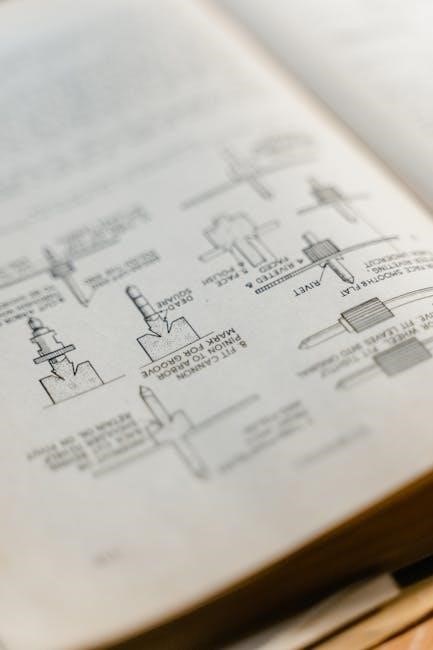ryobi line trimmer manual
Safety Precautions and Warnings
Always read the manual before operating the Ryobi line trimmer. Ensure the cutting line does not extend beyond the guard. Avoid operating without the guard. Use only authorized parts to prevent risks. Keep the trimmer out of reach of children. Wear protective gear‚ including gloves and eyewear. Operate the trimmer in the “RUN” position and avoid overreaching. Never mix fuel directly in the tank. Follow all safety symbols and instructions to ensure safe operation.
1.1 General Safety Warnings
Always read and understand the manual before using the Ryobi line trimmer. Ensure the cutting line does not extend beyond the guard‚ as this can cause injury. Never operate the trimmer without the guard or with damaged parts. Use only authorized replacement parts to avoid risks. Keep children and pets away while operating. Wear protective gear‚ including gloves and eyewear‚ to minimize injury risks. Avoid overreaching or operating in wet conditions. Follow all safety symbols and instructions provided in the manual. Proper maintenance and inspection are crucial to ensure safe operation. Never mix fuel directly in the tank if applicable.
1.2 Understanding Safety Symbols
Familiarize yourself with the safety symbols on your Ryobi line trimmer and in the manual. These symbols indicate potential hazards and crucial safety information. The warning symbol alerts you to dangerous situations that may cause injury. The prohibition symbol‚ such as a line through a battery‚ indicates actions to avoid‚ like incorrect battery use. The caution symbol warns of hot surfaces or moving parts. Always check the manual for symbol explanations. Understanding these symbols is essential for safe operation. They guide proper usage‚ maintenance‚ and precautions to prevent accidents. Refer to the manual for a detailed explanation of each symbol and its meaning.

1.3 Operating Precautions
Operate the Ryobi line trimmer only as intended. Always maintain control and avoid overreaching. Keep the cutting line within the guard to prevent accidents. Use the trimmer in the “RUN” position and avoid cutting tall grass from the bottom up‚ as this can cause grass to wrap around the shaft. Do not operate the trimmer without the guard or with the line extended beyond it. Ensure the battery is properly charged and avoid using unauthorized parts. Regularly inspect the trimmer for damage or wear. Operate the trimmer only in well-ventilated areas and keep it out of reach of children. Follow all safety guidelines for optimal performance and safety.

Product Overview and Features
Ryobi line trimmers offer reliable performance with cordless convenience‚ featuring powerful motors‚ adjustable cutting widths‚ and ergonomic designs. They are ideal for maintaining yards of varying sizes.
2.1 Key Features of Ryobi Line Trimmers
Ryobi line trimmers are designed for efficiency and versatility‚ offering cordless convenience‚ powerful lithium-ion batteries‚ and adjustable cutting widths. They feature robust motors for tough trimming tasks‚ lightweight designs for reduced fatigue‚ and ergonomic grips for comfortable handling. Many models include a rotating head for edging capabilities and a variable speed trigger for precise control. Some versions also offer expandable compatibility with other Ryobi tools‚ allowing users to share batteries across their ecosystem. These features make Ryobi trimmers ideal for both small gardens and larger yards‚ providing reliable performance and adaptability.
2.2 Compatible Models and Specifications
Ryobi line trimmers are available in various models‚ each designed for specific tasks and user preferences; Popular models include the RY40210‚ RY40220‚ and RY40270‚ offering different voltage options and cutting capacities. These trimmers are compatible with Ryobi’s 40V lithium-ion battery platform‚ ensuring consistent power and runtime. Specifications vary by model‚ with features like adjustable cutting widths (up to 18 inches)‚ dual-line feed systems‚ and variable speed controls. All models are designed to work seamlessly with Ryobi’s range of attachments‚ expanding their functionality for diverse yard care needs. Always refer to the manual for exact specifications and compatibility details.
2.3 Design and Build Quality
Ryobi line trimmers are constructed with durability and user comfort in mind. They feature lightweight yet robust materials‚ such as high-quality polymers and aluminum shafts‚ reducing fatigue during extended use. Ergonomic designs include padded handles and adjustable grips‚ ensuring a comfortable fit for various users. The trimmers are built with weather-resistant components‚ enhancing longevity and performance in outdoor conditions. Additionally‚ Ryobi incorporates innovative features like automatic line feeding systems and balanced engines for smoother operation. These design elements ensure reliability and efficiency‚ making Ryobi trimmers a reliable choice for yard maintenance. Their build quality aligns with their reputation for delivering durable‚ high-performance tools.

Assembly and Installation
Begin by unboxing and organizing all components. Attach the handle by aligning the mounting points and securing with provided bolts. Assemble the shaft by inserting the lower section into the upper section until it clicks. Install the cutting line by winding it around the spool following the arrows. Ensure all parts are properly aligned and tightened for safe operation. Refer to the diagram for precise assembly steps to avoid misalignment or loose connections;
3.1 Unboxing and Initial Setup
Begin by carefully unboxing the Ryobi line trimmer and verifying all components are included. Inspect for any visible damage or missing parts. Locate the trimmer unit‚ handle‚ cutting line spool‚ and hardware packet. Read the manual thoroughly to familiarize yourself with the tool and its operation. For cordless models‚ charge the battery fully before use. Gather necessary tools like a screwdriver for assembly. Place the trimmer on a flat surface to prepare for handle attachment and shaft assembly. Ensure all safety precautions are reviewed before proceeding to the next steps.
3.2 Attaching the Handle and Shaft
To attach the handle and shaft‚ align the handle with the shaft’s mounting bracket. Insert the provided screws through the pre-drilled holes and tighten securely using an Allen wrench or screwdriver. Ensure the handle is straight and evenly spaced for comfortable grip access. Tighten all connections firmly to prevent loosening during use. Double-check the alignment to ensure proper balance and functionality. No additional tools beyond those provided are typically needed. Once attached‚ test the handle’s stability by gently tugging on it. A secure connection is crucial for safe and effective operation of the Ryobi line trimmer.
3.3 Installing the Cutting Line
Open the spool by pressing the release tab and carefully remove any packaging materials. Cut a length of Ryobi-approved cutting line‚ ensuring it matches the recommended diameter specified in your manual. Wind the line clockwise around the spool‚ leaving about 6 inches unwound. Secure the end by inserting it into the spool’s retaining notch. Reattach the spool to the trimmer head‚ ensuring it clicks firmly into place. Pull the line gently to ensure it’s properly seated and not tangled. Always use genuine Ryobi replacement line for optimal performance and safety. Avoid overfilling the spool‚ as this can cause operational issues.

Operating Instructions
Follow proper techniques for efficient trimming. Start the trimmer according to the manual‚ adjust settings for different tasks‚ and use attachments for versatility. Always maintain control.
4.1 Starting the Trimmer for the First Time
Before starting‚ ensure the trimmer is fully assembled and all safety precautions are followed. Refer to the manual for specific instructions. Wear protective gear‚ including gloves and safety glasses. Prime the engine by pressing the primer bulb 2-3 times until it feels resistant. Move the choke to the “start” position and pull the starter rope firmly until the engine ignites. Allow the trimmer to warm up for a few seconds before use. If equipped with a recoil starter‚ ensure the cutting line is not touching any surfaces during startup. Always follow proper starting procedures to avoid damage or injury.
4.2 Proper Cutting Techniques
For efficient and safe trimming‚ maintain the cutting line at a 20-degree angle to the ground. Keep the trimmer moving in a steady‚ sweeping motion to avoid uneven cuts. Do not cut too close to plants or flowers to prevent damage. Use the appropriate line thickness for the job‚ with thicker lines for heavier growth. Avoid cutting in one spot for too long‚ as this can overload the motor. Always keep the cutting line parallel to the ground and avoid touching hard surfaces‚ which can damage the line or trimmer. Regularly inspect the area to ensure even cutting and adjust as needed.
4.3 Using Attachments and Accessories
When using attachments and accessories with your Ryobi line trimmer‚ ensure compatibility by referring to the manual. Attachments like edging wheels or brush cutters can enhance functionality. To install‚ align the attachment with the shaft‚ secure it with the provided hardware‚ and tighten firmly. Always wear protective gear‚ including gloves and safety glasses‚ when operating with attachments. Regularly inspect attachments for wear and tear‚ replacing them as needed to maintain performance and safety. Follow manufacturer guidelines for each accessory to ensure optimal use;

Maintenance and Care
Regular maintenance ensures your Ryobi line trimmer performs optimally. Clean the trimmer after each use‚ inspect for damage‚ and store it in a dry place. Check and replace the cutting line properly as needed.
5.1 Cleaning the Trimmer
Regular cleaning is essential to maintain your Ryobi line trimmer’s performance. Turn off the engine and allow it to cool before cleaning. Use a soft-bristled brush or cloth to remove dirt‚ grass clippings‚ and debris from the exterior‚ including the cutting head and guard. Avoid using harsh chemicals or high-pressure washes‚ as they may damage components. Wipe down the shaft and handle with a damp cloth. For the air filter‚ gently tap it to remove dust or replace it if necessary. Regular cleaning prevents corrosion and ensures smooth operation. Always dry the trimmer thoroughly before storage.
5.2 Storing the Trimmer
Proper storage is crucial to maintain your Ryobi line trimmer’s condition. After cleaning‚ store it in a dry‚ cool place away from direct sunlight. For gas-powered models‚ drain the fuel tank or use a fuel stabilizer to prevent residue buildup. For electric models‚ unplug the trimmer and store it securely. Avoid storing in humid or extreme temperature environments. Check for any damage before storage and use a protective cover to shield from dust. This ensures longevity and optimal performance when you next use the trimmer. Always refer to the manual for specific storage recommendations for your model.

5.3 Replacing Parts and Accessories
Regularly inspect your Ryobi line trimmer for worn or damaged parts. Replace the cutting line when frayed or broken‚ using genuine Ryobi replacements for optimal performance. To replace other parts‚ such as the trimmer head or shaft‚ refer to the manual for specific instructions. Always turn off the engine or unplug the trimmer before making adjustments. Use only authorized Ryobi accessories to ensure compatibility and safety. Store replaced parts securely‚ and dispose of them responsibly. For assistance‚ contact Ryobi customer support or visit their official website for genuine replacement options.

Troubleshooting Common Issues
Address common issues like line breakage‚ starting problems‚ or damaged parts by referring to specific troubleshooting guides within this manual for effective solutions.
6.1 Line Breakage Solutions
If the cutting line breaks frequently‚ check if the line size matches the trimmer’s specifications. Ensure the line is properly wound on the spool without overlapping. Avoid using damaged or uneven line‚ as this can cause premature breakage. If the issue persists‚ inspect the cutting head for debris or damage. Replace worn-out parts like the spool or line eye. Regularly cleaning the head and ensuring proper tension can prevent breakage. For severe cases‚ consult the manual or contact Ryobi support for assistance. Always follow the manufacturer’s guidelines for line replacement and maintenance to optimize performance and longevity.
6.2 Issues with Starting the Trimmer
If the trimmer fails to start‚ ensure the fuel tank is filled with the correct fuel mix specified in the manual. Check the spark plug for cleanliness and proper installation. A clogged air filter or blocked fuel line can also prevent starting. Verify the choke is in the correct position and the primer bulb is functioning. If issues persist‚ inspect for loose connections or damaged ignition components. Consult the manual for troubleshooting steps or contact Ryobi customer support for professional assistance. Regular maintenance‚ such as cleaning the carburetor‚ can help resolve recurring starting problems and ensure optimal performance.
6.3 Handling and Repairing Damaged Parts
Inspect damaged parts immediately to prevent further harm. For a broken cutting line‚ replace it with a compatible Ryobi trimmer line. If the trimmer head is damaged‚ remove it and install a new one. For shaft damage‚ disconnect the spark plug and carefully replace the shaft. Always use genuine Ryobi parts to ensure compatibility and safety. If unsure‚ refer to the manual or contact customer support. Regularly check and maintain parts to avoid damage and extend the trimmer’s lifespan. Proper handling and timely repairs will ensure optimal performance and safety while using the Ryobi line trimmer.

Accessories and Upgrades

Explore a variety of accessories and upgrades to enhance your Ryobi line trimmer’s performance and versatility. From replacement lines to powerful attachments‚ upgrade options designed to boost efficiency and productivity.
7.1 Compatible Trimmer Lines
Choose from a variety of compatible trimmer lines designed for your Ryobi line trimmer. Options include round‚ square‚ and twisted lines‚ each offering unique cutting performance. Round lines are durable and ideal for thick vegetation‚ while square lines provide cleaner cuts. Twisted lines reduce noise and vibration. Always use genuine Ryobi replacement lines or compatible aftermarket options to ensure optimal performance and safety. Check your trimmer’s manual for recommended line sizes and types. Using incorrect lines can damage the trimmer or void the warranty. For heavy-duty tasks‚ consider high-strength Shank lines or SpeedFlex lines for reduced noise and improved efficiency.
7.2 Additional Attachments
Ryobi line trimmers offer a range of additional attachments to enhance versatility. These include edger attachments for clean border work‚ brush cutter blades for heavy-duty clearing‚ and hedge trimmer attachments for precise shrub shaping. Many models are compatible with Ryobi’s Expand-It system‚ allowing quick tool-less changes. These attachments transform your trimmer into a multi-functional yard care tool‚ saving space and reducing the need for multiple devices. Always ensure attachments are compatible with your trimmer model for optimal performance and safety. Explore the full range of Ryobi attachments to maximize your trimming experience and tackle various yard tasks efficiently.
7.3 Upgrade Options for Enhanced Performance
Ryobi line trimmers can be upgraded for improved performance. High-capacity batteries offer longer runtime‚ while upgraded motors provide more power for dense vegetation. Premium cutting lines‚ like those with metal reinforcements‚ last longer and cut thicker growth efficiently. Ergonomic handles and shoulder straps reduce fatigue during extended use. Additionally‚ performance-enhancing parts like tuned exhaust systems or advanced air filters can boost efficiency. For users seeking more power‚ Ryobi’s gas-powered models or Pro models with higher torque are excellent upgrades. Always ensure upgrades are compatible with your trimmer model for optimal results and safety.
